The Amazin’ True Story of Piazza, Clemens and the Broken Bat
From the book So Many Ways to Lose, by Devin Gordon. Copyright © 2021 by Devin Gordon. To be published on March 16, 2021 by Harper, an imprint of HarperCollins Publishers. Reprinted by permission.
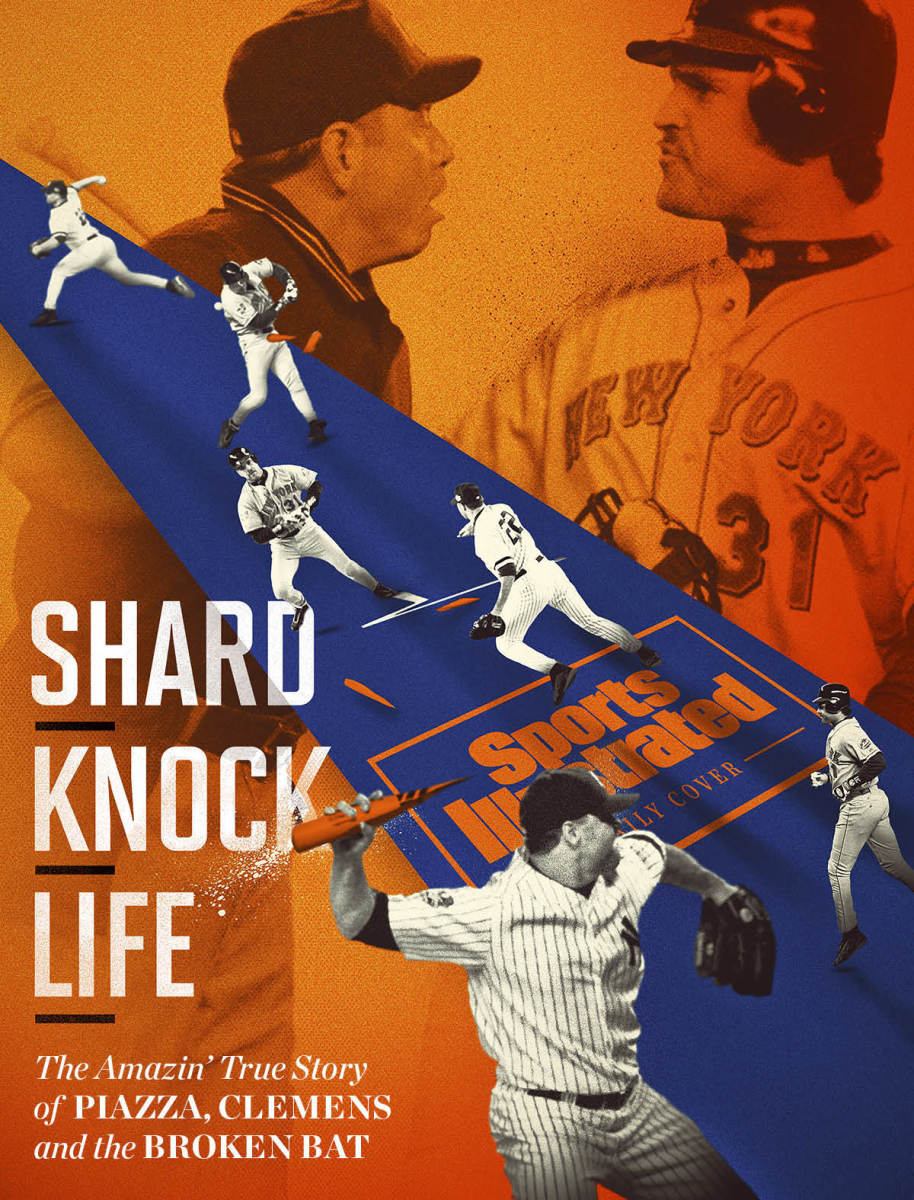
So there they were, Mike Piazza and Roger Clemens, 11 years after the Incident at the Subway Series between the Mets and the Yankees in 2000, infamous nemeses now settling into easy breezy retirement, wedged next to each other on a pair of folding chairs at Michael Jordan’s celebrity golf tournament in Las Vegas, live on a talk-radio show, hot mics in front of them. Together again, at last.
The key chapters of that whole saga—Piazza’s repeatedly owning Clemens at the plate; Clemens’s responding like a big, fat psycho baby with a fastball to Piazza’s skull, knocking him out with a concussion; then Game 2 of the World Series, the showdown in front of the whole world, the shattered bat, the jagged shard that Clemens may or may not have slung in anger at Piazza, the benches emptying, the near brawl—none of it ever got resolved with a peace accord.They never hashed it out years later, they never put it behind them and they never will. Mike Piazza and Roger Clemens and the broken bat during the Subway Series will connect them forever.
So much has changed in New York since then. George Steinbrenner is dead, and so is one of his sons. The Mets—the Mets!—now have the richest owner in baseball, the second coming of Tom Seaver in their rotation, a home run king at first base and Francisco Lindor—Francisco Lindor!—playing shortstop. It’s been so long since the Yankees have been to the World Series that they have to ask Mets fans what it feels like. As a lifelong Mets fan myself, though, I can assure that on a genetic level, nothing has changed. Steve Cohen (estimated worth: $12 billion) could buy the Yankees (estimated worth: $8 billion) and make them rent out Yankee Stadium, and they’d still be the Evil Empire. Meanwhile, if we’ve learned nothing else from the Mets this offseason, it’s that they’ll always be the Mets. Piazza and Clemens were two of the greatest ever to play their positions, but in retirement their legacies have gone in opposite directions. Piazza can seemingly do no wrong with Mets fans, no matter what he tries, and in 2016, on his fourth attempt, he got elected into the Hall of Fame with 83% of the vote. Clemens, on the other hand, has become the Lance Armstrong of baseball, another straight-shootin’ Texan brought low by a cheating scandal, and now Yankees fans talk about him as though he’s just a guy they used to work with for a while. Put “Piazza” and “Clemens” in the same sentence, though, and two decades later, every baseball fan of a certain age starts downloading the same video clip in our heads.
Until that afternoon in Las Vegas, they had been forced to interact only once, at the 2004 All-Star Game, when Clemens was in the NL with the Astros and Piazza had to catch him for an inning. “That was awkward,” Piazza says now. He’s a funny guy, dry and forthright. That night at the All-Star Game, Clemens got shelled, giving up six runs, five hits and two homers, which was magnificent, but it also made things even more awkward. “I think maybe he was feeling the same thing,” Piazza says. “I think we just didn’t know what to say.” Before the game, one reporter had asked Piazza whether he and Clemens were kosher enough to do their jobs together, should the circumstances require it. Sure, Piazza said. He could’ve left it at that, but he couldn’t resist sneaking in a quick joke: “I don’t know if we’re gonna be playing golf anytime soon.”
Seven years later, here they were, playing golf together. Not together together. They weren’t playing partners, but they were at the same tournament. They were playing in the same place at the same time. After Piazza finished his round, a local sports-talk producer from an ESPN drive-time show called Gridlocked buttonholed him and asked whether he’d sit down for a quick interview. Sure, Piazza said. It was a charity event, after all.

“It never occurred to me I was walking into an ambush,” he says now. Piazza still gets asked about Clemens, but not nearly as often now, and somehow, he tells me, he’d forgotten for years about this lower-case-i incident at the Jordan Invitational. He’s never mentioned it before, and now the absurdity of it all is coming back to him. He recollects feeling woozy for the rest of the afternoon. You know that perforated sensation you get when you’re trying to process a bizarre encounter and you still aren’t quite sure it really happened? That one. He’d wonder about who knew what and when, how the chess pieces got arranged around him, how he fell for it. He feels good about how he handled it. Dignified, professional, even though he was seething so hard for all six minutes that he was glad it was radio. If it’d been on live TV, everyone would’ve seen the steam pouring out of his ears as he failed to disguise the shock that someone would do him so dirty.
For a few minutes Piazza and the radio host kibbitzed about golf and baseball. All the usual. But hey, speaking of baseball, the host began, Roger Clemens is here at this tournament, too, isn’t he? Piazza knew he was. Both of them had participated the year before, too, but they’d always managed to keep a few holes between them. Not this time. In fact, the host told listeners, here’s Clemens right now, coming over to join us on the air.
At first, Piazza says now, he thought the ESPN guy was messing with him. Surprise! It’s your mortal enemy! Haha.
And then Clemens sat down next to him.
The Mets clinched the NL pennant on Oct. 16, 2000, the Yankees finished off the Mariners in the ALCS the following night and, for Mets fans at least, the next four days leading up to Game 1 of the Subway Series were pure bliss. Not just because the Mets had reached the mountaintop of sports once again, but let’s do pause on that for a moment. The World Series! The Mets! This keeps happening! Miracles are supposed to happen once in a lifetime, and yet here were our Mets, making their fourth trip in 31 years. Sure, yes, this was the Yankees’ fourth trip in—hang on, just counting up—five years. But those are the Yankees. They’re supposed to make it every year, and whenever they don’t, I’m always surprised that every last member of the franchise doesn’t self-immolate in shame. The Yankees keep winning rings. That’s what they do. (Or at least they used to. It’s been—hang on, just counting up—12 years.) The Mets keep conjuring miracles from spare car parts. That’s what we do.
And! A Subway Series!
Everyone got swept up in the mania, and by “everyone” I mean residents of the New York tristate area and nowhere else in America. If there’s one thing Mets and Yankees fans should be able to agree upon, but won’t, just because, it’s that we both got screwed on the timing. If the same matchup had occurred a year later, six weeks after 9/11, it would’ve been the most emotionally cathartic World Series ever staged. But we weren’t that city yet. In 2000 for the rest of sports-loving America, the Subway Series was a case of the fattest cats getting fatter. This was still “Giuliani Time” New York City, not post-9/11 New York, and even lots of New Yorkers didn’t love New York in those days. The Yankees, the NYPD and Wall Street, three pillars of city power brought low in the late 1980s, were back on the upswing. Mayor Rudy Giuliani was a Yankees fan, of course, and throughout that interminable dynasty, I took solace in hating the sight of his stupid Edvard Munch face in the front row behind home plate. What an ass----. He just had to have the seat right behind home so he could be on camera the whole game, didn’t he? Like a campaign ad. Like the Yankees were his running mate.
The Mets, on the other hand, showed the Yankees what true class looked like by selecting the Baha Men’s “Who Lets the Dogs Out” as our theme song and victory anthem for the 2000 playoff run. Who let the dogs out / Who, who, who, who, who? the chorus went. Who let the dogs out / Who, who, who, who, who? So if you’re wondering what the Subway Series looked like to people outside of New York, that pretty much summarizes it: “Giuliani Time” vs. “Who Let the Dogs Out.”
The 2000 Mets weren’t cheeky upstarts like the 1969 team, or a talent-packed machine like the ’86 team. They were a roster of solid, steady professionals who made a historically low number of errors, threw strikes, scratched out runs and outsmarted teams with their ace in the hole, their Einstein in the dugout, the very, very smart Bobby Valentine, the smartest skipper who ever smarted, a man so smart that he claims to have invented the sandwich wrap. He’s been claiming this for years, and if you ask me, this little detail explains so much about him. Because when it comes to Bobby Valentine talking about Bobby Valentine, it’s typically safe to assume he’s full of s---, except ... it really does appear that Bobby Valentine invented the sandwich wrap. At the very least, the known facts appear to corroborate his claim.
The Yankees, meanwhile, were at the peak of their dullest dynasty yet. At least Reggie Jackson and Mickey Mantle were fun. Now it was the Snore Four. I don’t believe this anymore, but I used to have a theory that those Yankees were to blame for the subsequent Steroid Era because they’d put a choke hold on the sport and it was running out of oxygen. (O.K., I still believe this.) They were at a stage of dominance where the only real enemy is complacency, plus the fatigue from playing nearly 200 baseball games for several years in a row. That’s how all dynasties end—not with a bang but with sleep apnea. By October 2000, the Yankees were catatonic. They went 2–13 down the stretch, ending the regular season on a seven-game losing streak. It got so bad that some Yankees fans were calling for Joe Torre to be the first manager ever fired on the eve of the playoffs, coming off two straight World Series titles. One of the Yankees fans calling for Torre to be fired was George Steinbrenner, who owned the team, and if he could’ve done it without a clubhouse revolt, he would have.
And that’s when it would dawn on everyone in Yankee Nation: Oh my God, we’re going to lose the World Series ... to the Mets. All of our rings, all of our history, all these years of smug superiority—if we lose this, it’ll all vanish. They’ll have this forever. It will be the end of everything.
Correct.
It would be so unfair. It would be factually ludicrous. It would be, in a word, amazing. Any idiot could see that there was no real debate over which franchise was superior in any rational sense of the word. But it wouldn’t matter, and they knew it. Head-to-head is the only scoreboard that counts. Sorry, that’s just how it works.
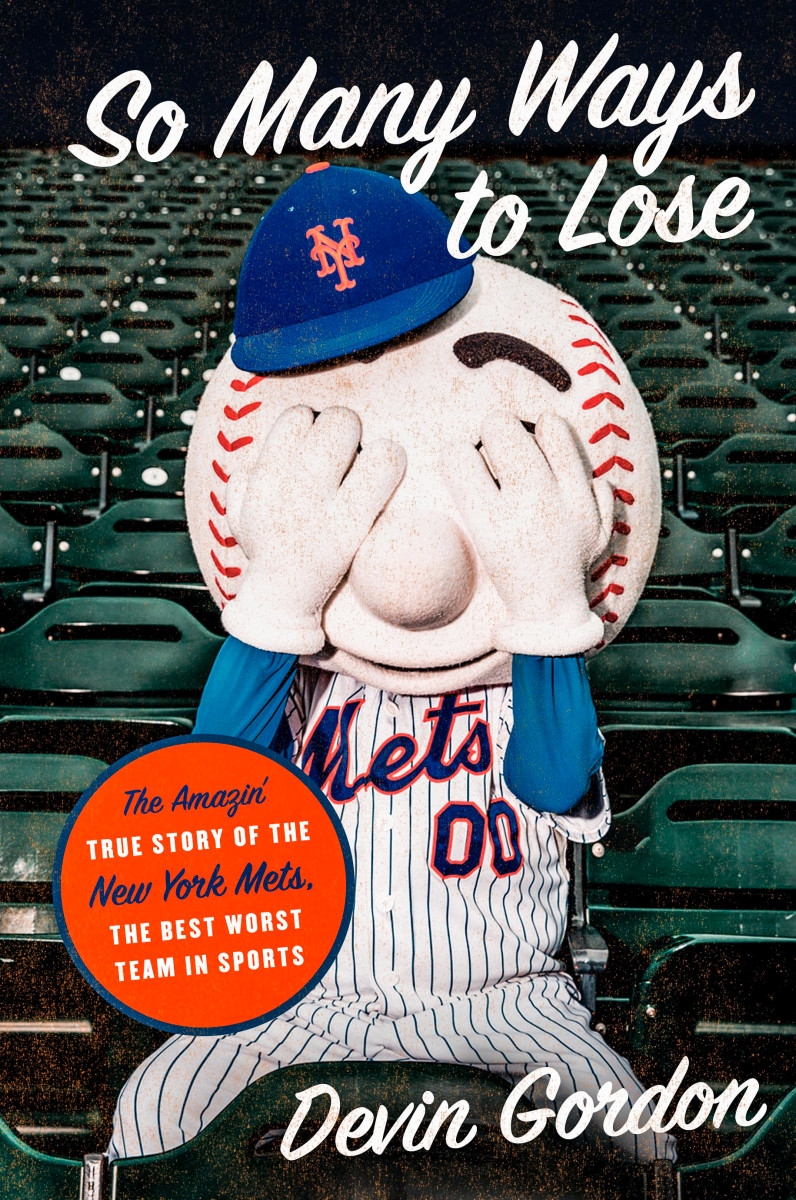
Preorder So Many Ways to Lose: The Amazin' True Story of the New York Mets―the Best Worst Team in Sports
This was the true joy, the thing I will always savor, about the 2000 Subway Series: Those first few days before it began, when the wait was on, the outcome was up in the air, and the only thing Yankees fans could do was squirm with terror. God, it was so great. Trolling Yankees fans that October was such a joy, especially when our own anxiety, while not insignificant, could never soar to the heights those poor bastards reached that month, like the instant after you realize you’ve lost your wallet and before you remember it’s in your pocket.
Look, everyone in the city knew how this was going to end. We could read the rosters. Supposedly this was it for the Yankees dynasty and the breakup was coming. No. Bulls---. The Snore Four were just in hibernation. We weren’t falling for their ruse.
Neither roster stirred many loins. The Yankees were the Yankees, as we’ve established. And while that particular 2000 Mets team was a garden of tiny baseball pleasures for the connoisseurs, for everyone else they were a starchy sequel to the comic-book roster the Mets somehow had assembled in 1999. I still have my scorecard from Game 1 of the Subway Series, and every so often I’ll glance at it and wonder how this dry hacking cough of a lineup scored enough runs to play .500 baseball, let alone reach the postseason. All of humanity was counting on us to take down the final boss, and we showed up with an outfield of Benny Agbayani, Timo Pérez and Jay Payton. Our crafty, veteran lefthander Al Leiter was back, but aside from ex-Astros ace Mike Hampton, the rest of the rotation was the same flotsam that got the Mets jetsam’d against the Braves in the 1999 NLCS. (And Hampton wasn’t that great.) What they all had in common, though, was a knack for inducing ground balls. The 2000 Mets couldn’t hit much and they couldn’t pitch much and they were very old and very slow, but oh, baby, could Edgardo Alfonzo range to his right, stab a grounder and flip it to Rey Ordóñez for the smooth relay over to Todd Zeile at first, completing the sexiest 4-6-3 double play this side of FlashDancers.
In order to beat the Yankees—which, to repeat, was not going to happen—the Mets would need to be more than perfect. We needed all of the weird miscellany that occurs in a short series to go our way. We needed all of the juju swirling in the atmosphere to nudge some foul balls fair, get a few borderline calls to go our way. We needed the baseball gods to decide it was time to punish the Yankees and bless us with their most amazin’ miracle yet.
The gods replied right away, and their message was clear: New phone—who dis?
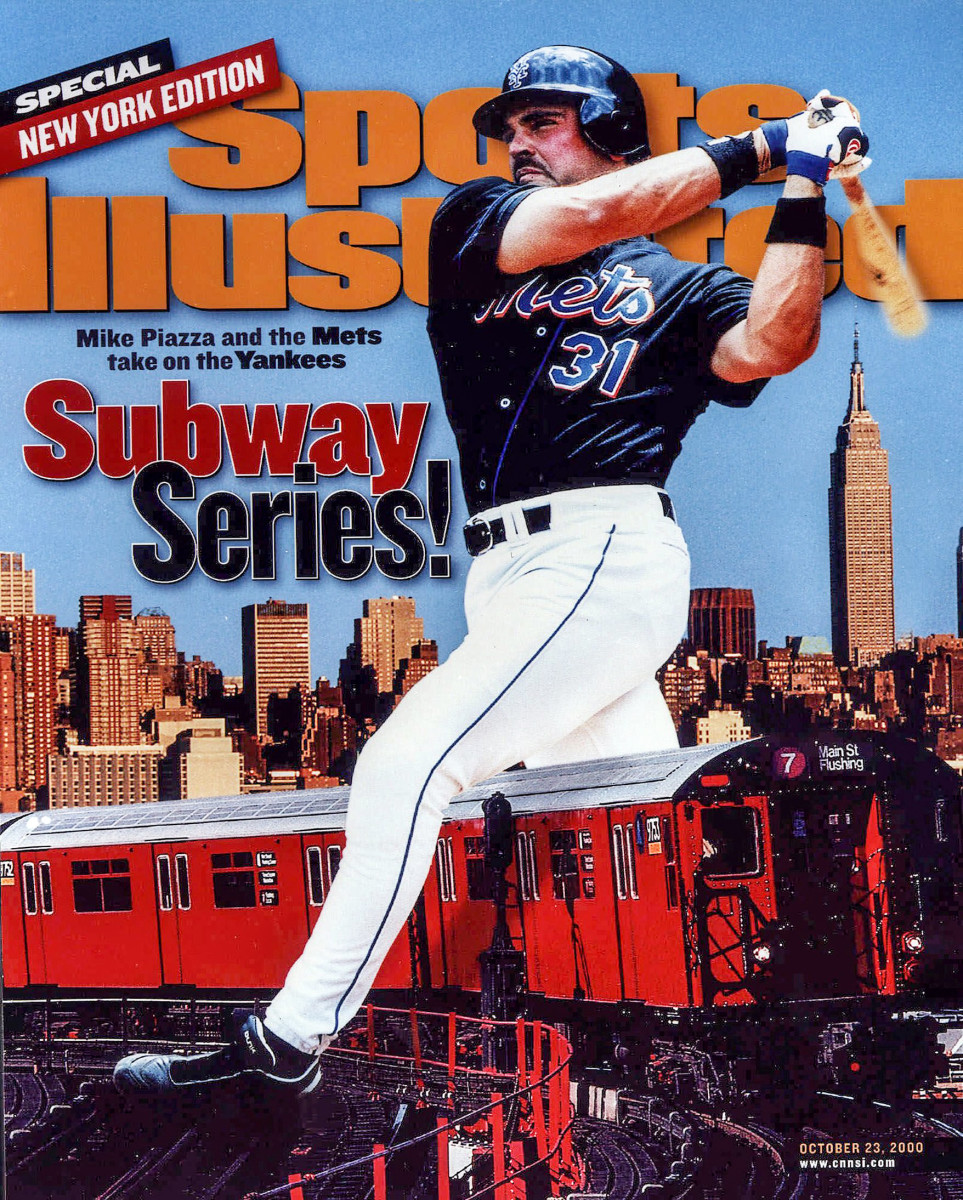
It was meaner than ghosting. It seemed almost intentional, as if the gods had snickered and said, O.K., now watch this. Game 1 at Yankee Stadium was a marathon extra-inning affair with a late comeback, defensive gems, a blown save in the ninth and a walk-off hit in the 12th inning, but that sort of makes it sound exciting. If it’s hard to imagine such a close game in the World Series doing so little to move anyone’s blood pressure, maybe this will help: After Armando Benítez blew a one-run lead in the ninth, Mets batters went nine up and nine down in the 10th, 11th and 12th innings, and it never once felt like we were going to get another hit, let alone score another run. We were just waiting for the Yankees to get it over with, which they finally did in the bottom of the 12th on a first-pitch single by utility infielder José Vizcaíno. Ball game. Can you feel the chills?
Out of nearly five hours of baseball, only one play during Game 1 really mattered: After five scoreless innings, with two outs in the top of the sixth and speedy Timo Pérez on first, Zeile launched a fly ball to deep left off Andy Pettitte that sounded gone off the bat. Pérez was so sure it was a home run that he trotted slowly to second base, his fist in the air, watching and celebrating. He kept it up there until a split second after the ball struck the top lip of the wall and bounded back into play, directly into Yankees left fielder David Justice’s bare hand. Then, two split seconds too late, Timo hit the jets. Justice had a slingshot arm, but his strong throw back to the infield pulled Derek Jeter ever so slightly off-balance toward the left-field line, forcing him to wheel around and make a relay throw home—across his body—that was so perfect he deserves to spend the rest of his life in prison for it. Jeter was overrated defensively his whole career, and by the end he was straight trash, but in the postseason he turned into a clairvoyant octopus. He gunned down Timo by an inch at the plate, and instead of the Mets being up a run with Zeile on second base, the game was still scoreless and the inning was over.
Timo’s mistake was clumsy enough to be classified as a blunder, but it wasn’t Bucknerian, and he also wasn’t the only 2000 Met who suddenly turned sloppy. Inning after inning, the Mets kept doing little things wrong, and the slow accretion of bad mojo was impossible to ignore. It also made Game 2 a must-win for the Mets. We had Mike Piazza and an outfield teleported from 1962. If we went down two games to none, we were cooked.
And anyway, Game 2 was always going to be the main event from the moment Torre announced that Roger Clemens would start. It’d been baseball’s biggest story line all season—Piazza versus Clemens, Clemens versus Piazza—and somehow, preposterously, it was cresting in the World Series. For once, a clash of titans would get settled on the field. And because Piazza was batting third for the Mets, the showdown would begin right away, in the top of the first inning, before anyone’s popcorn had time to cool.
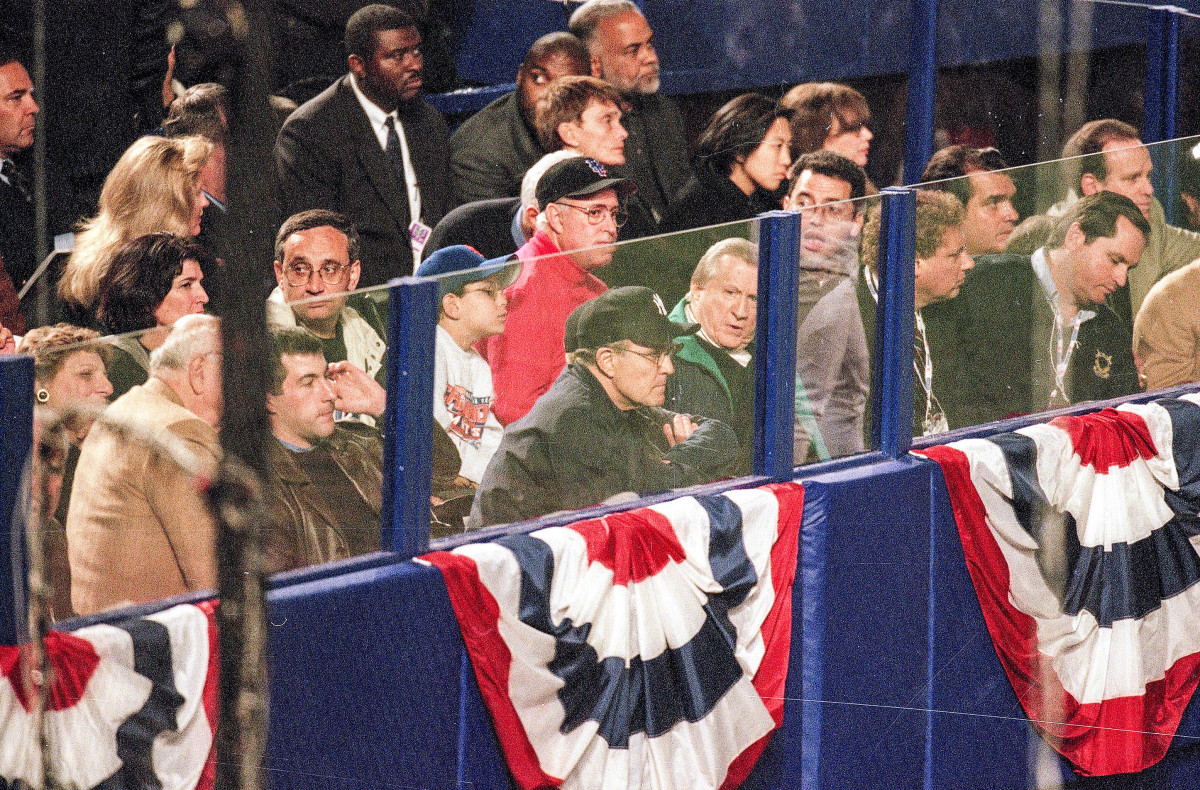
It’s near midnight in Italy, where Mike Piazza is calling from, and everyone in the house is sound asleep. A few years ago Piazza bought a stake in an Italian soccer club in a town called Reggio Emilia, in the north near Milan, and he moved the whole family there—his wife, his three young kids. The soccer club turned into whatever the Italian word is for a farrago, but Italy stuck. They loved it so much they decided to stay. His kids speak fluent Italian now, which makes him proud. Since his retirement in 2008, Piazza has transitioned from perennial Mets All-Star to bleeding-orange-and-blue Mets fan, and one downside of living in Italy is that most games begin at 2 a.m. local time, so he watches highlights on Sling the next morning while he gets the kids ready for school.
We’re speaking well above a whisper, but it’s dark out and the house is quiet and we can’t see each other, so it feels a bit like confessional. This comes naturally to Piazza. He’s still a Catholic boy from Main Line Philly. He takes his kids to church every Sunday. The first time we’d spoken, a few weeks earlier, his melodrama with Clemens didn’t come up at all. This time, though, we laughed as we realized we’d lingered on it much longer than either of us had intended. He doesn’t mind talking about it—he still gets asked about Game 2 all the time—it’s just, well, what else is there to say? Within days it’d already earned the dreaded “Zapruder” designation, and that was almost 20 years ago. Twenty years!
Memory is a funny thing. The facts stay fixed, but the forces of time shift and shape how we feel about them. Nothing about what happened on that night in the Bronx has changed, but we have. The world has. Piazza got trapped in a generational divide that went deeper than baseball and into questions of professionalism and masculinity that you can still hear him thinking through today. After the game, he got criticized by his own teammates for his refusal to charge Clemens and throw a punch, for letting his cooler head prevail. His very manhood was called out in the middle of the World Series, for restraining himself from getting tossed in the first inning of a game the Mets had to win. His meticulous ability to process visual information at a world-class rate, the thing that made him such a special hitter, helped him hold his fist back when he saw the confused look on Clemens’s face—not the expression of violent intent. Piazza simply wasn’t old-school like that. He had this weird thing about not punching people unless he had a really good reason.
Baseball’s Old Testament was written by an angry God, though, and according to its rules, this otherworldly restraint was a sign of weakness and a lack of commitment, the conduct of a me-first prick. Piazza, meanwhile, was one of the early authors of a New Testament, a pioneer of what has come to be called the “player empowerment age.” He was the son of a car salesman who’d taught him to negotiate hard, stick up for your worth, and don’t let anyone use sentiment, or accusations of disloyalty or cowardice, to take advantage of you.
In the simplest sense Piazza wound up in New York in the first place because of money. But really it was because he challenged the unwritten rules of baseball. Everyone who followed the game in that era knew Piazza’s legend: unheralded as a high school player, drafted in the 62nd round only as a favor to his godfather, Dodgers manager-emeritus Tommy Lasorda. Piazza could always hit the ball a mile, but he was raw and positionless, a first baseman who’d been converted to catcher in order to increase his odds of slugging his way into a pro career. That was in 1988. By the end of ’93, his first full season in the majors, he was the unanimous Rookie of the Year, and within three years he was the greatest-hitting catcher of all time—a frightening middle-of-the-order masher at a position where they simply do not exist.
Piazza was so electrifying in Los Angeles that some fans arrived as early as the first inning to watch him hit. One of them was Jimmy Kimmel, who at the time was hosting a local sports radio show and doing stand-up at night. Kimmel had gradually moved west as a kid, from Brooklyn to Las Vegas when he was nine, and then on to L.A., and his loyalty to the Mets was facing its greatest crisis yet in the person of Piazza, whom he had dubbed “squatting Jesus.” For Kimmel, Piazza was more than just a superstar—he was an ethnic icon. “I would always call him ‘Italian American superstar catcher Mike Piazza,’ ” Kimmel says now. “I don’t think I ever just said his last name.”
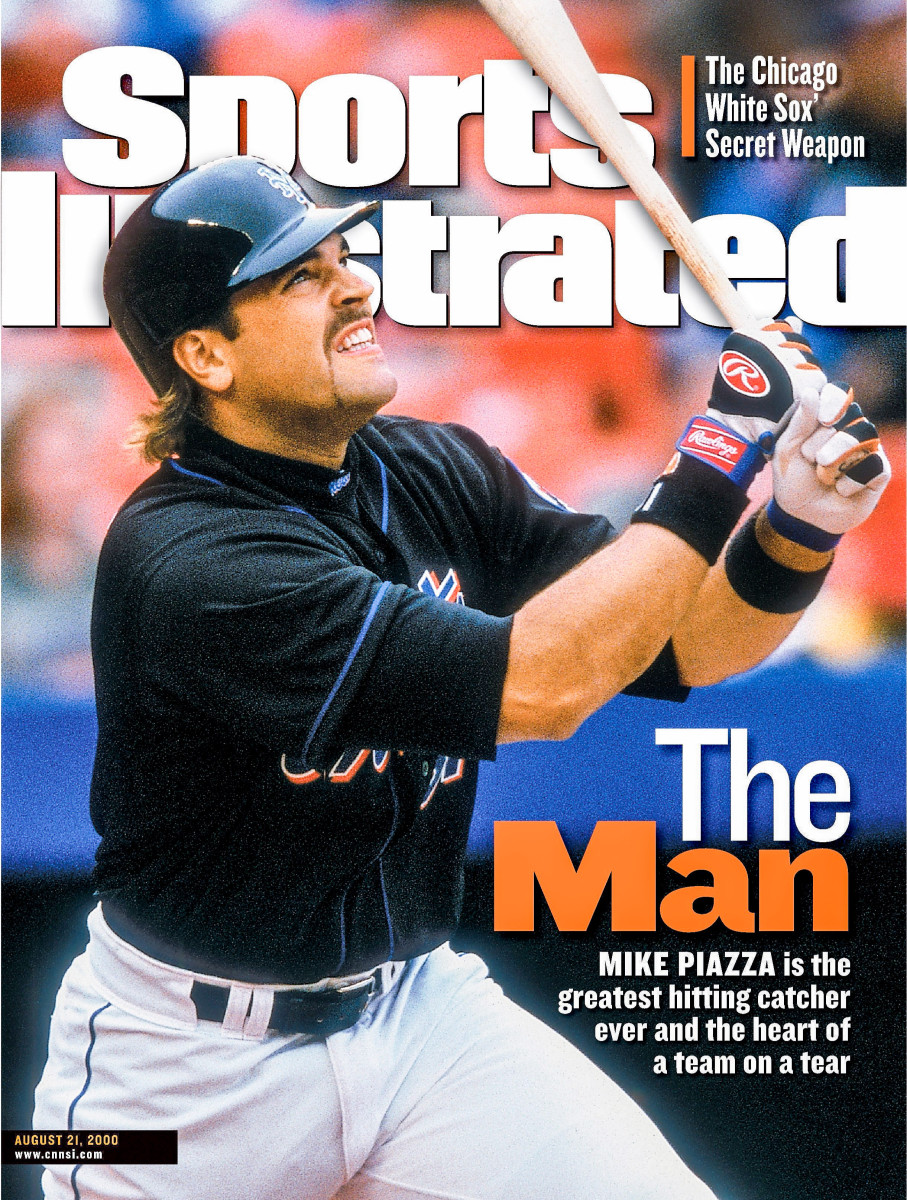
In 1997, Piazza had his most dominant season yet, hitting a preposterous .362 (which made me gasp when I looked it up), as well as a career-high 40 home runs. Free agency was a year away, and the Dodgers were eager to lock him up long-term before anyone else got the chance to lure him away. Piazza, though, felt he was the game’s most valuable hitter—accurately, in retrospect—and he insisted on being paid like it, or he’d break off contract negotiations until after the season. If this had happened today, the vast majority of the sports world, including much of the sports media, would side with Piazza. Pay the man, or someone else will. We know how this works now. In ’97, no less than Vin Scully, the voice of the Dodgers himself, took a shot at Piazza, accusing him of holding the team “for ransom.”
Piazza may have miscalculated a few things. He had an ego, and his attitude could often be described as petulant. It’d be unfair to call him a prima donna, but the term attaches itself easily when you’re a cocky Italian power hitter with a muscle-car ’stache. He wasn’t the easiest guy to side with, in other words, even against a greedy front office. The end in Los Angeles was sudden. Mean things were said, promises were reportedly broken, backs were reportedly stabbed. Six weeks into the 1998 season, the Dodgers shipped Piazza to the rebuilding Marlins.
Kimmel went through all the stages of grief live on air. “I was so angry,” he says. “I actually sang a song on the radio to the tune of Neil Diamond’s ‘Hello Again,’ and I broke down halfway through the song. Then I collapsed on the floor and had to be carried out by my cohost.” Even worse, Piazza had been exiled to the Marlins. “It was like, Oh my God, what could be worse than this?” Kimmel recalls thinking. “It’s not even a real baseball team.” Eight days later, though, the rebuilding Marlins flipped “Squatting Jesus” to the Mets for a trio of prospects (including Mets legend Mookie Wilson’s nephew, Preston, who wound up having a nice career).
“I was so happy,” Kimmel says of the Italian American superstar–catcher’s arrival in New York. “It seemed like destiny was on my side for once.”
Piazza versus Clemens—or as Yankees fans call it, Clemens versus Piazza—began on June 6, 1999, at Yankee Stadium, and in order to understand the entire psychopathology here, it’s important to note that Yankees fans weren’t totally in on Clemens yet. He kept carpetbagging from one division rival to another, ring-hunting across the AL East from Boston to Toronto to New York. And now he was joining this homegrown band of brothers, this merry few who’d just won two of the last three World Series without him, thank you very much. What did they even need him for? And why was his head so fat now? It didn’t used to be like that. Yankees fans were very much still in “prove it” mode with Clemens, and this game—Sunday night, national TV, a packed house of 56,294, the Yankees looking for a sweep—was his first chance to show the home crowd that he was a killer, and not a third wheel.
The Mets, meanwhile, were off to their usual floundering start, with a 27–28 record, sitting on the cusp of a humiliating sweep in the Bronx. The kind of start that gets people fired. The Mets needed this game, or another season would be over before it began, which is a crucial part of the psychology behind Piazza’s role here.
For a historic power hitter, Piazza had an incongruously limp and unthreatening batting stance. He just kind of stood there with a worried look on his face. Then the pitch would come and suddenly he would look 6' 3", 215 pounds again, and he’d get his arms extended and swing so hard that the ball would seem to flatten before reversing itself, and the barrel of his bat would loop over his shoulder and bounce off his scapula. After a booming double in the second off Clemens, Piazza came up again in the third with a runner on first, and he clubbed a bad splitter over the wall in left-center, mullet bouncing as he trotted around the bases. 6–0. Clemens knew it was gone off the bat and didn’t even watch it go, just put up his glove for the umpire to toss him a fresh ball.
Piazza, for his part, didn’t flip his bat, didn’t show Clemens up, just did his trot with his head down, like he always did. Clemens walked off the field to boos from Yankees fans and a few scattered yelps from Mets fans who’d braved the hostile crowd. Afterward, and in the days that followed, Yankees fans assumed their usual scornful posture toward us. It’s June, you pitiful children. None of this matters. It mattered to us, and it sure as hell mattered to Roger Clemens.
That night turned the season around for the Mets. They followed up the win with a 15–3 tear, and by the time the Yankees arrived at Shea in early July for the second leg of the (lowercase) subway series, the Mets were back in the playoff race. Clemens pitched the series opener that time, and he had his good stuff until Piazza came up in the bottom of the sixth with the score tied, 2–2. Once again, Clemens let a pitch float an inch too high, and this time Piazza hit a low screamer that seemed like it was still rising when it whizzed over the left-field wall. “He’s done it again!” Gary Cohen, the voice of the Mets, bellowed on SNY as the ball left the park. “Mike Piazza off Clemens!” In five at bats that season against Clemens, Piazza was now 3-for-5 with a double and two exclamation-point home runs. And this time, since this was Shea Stadium, he took a curtain call.
Now Piazza versus Clemens was officially a thing.
Which brings us to June 9, 2000, at Yankee Stadium. Top of the third inning of a scoreless game, bases loaded, and who should come up to face Clemens? Mike Piazza. One serendipitous detail of the whole saga was the way that Piazza’s blasts kept getting bigger and more consequential. It began with a long double, then a two-run homer to ice a game, then a three-run homer to win a game. And now, in front of a sold-out Yankees crowd: a grand slam to dead center field, putting the Mets up 4–0 and breaking the dam on the worst outing of Clemens’s career. Torre put him out of his misery in the sixth inning, after he’d given up nine runs, driving his ERA up near five, dropping his record to 4–6, and prompting baseball’s chattering class to wonder if Roger Clemens might finally be washed up. (He wasn’t.) Piazza wasn’t just battering Clemens, he was pantsing him in front of his own fans, and I set up an IV drip in my living room so I could shoot that s--- straight into my veins.
Round 4 was a month later, at Yankee Stadium. It was the second game of a day-night doubleheader, and former Mets legend Doc Gooden had already won the opener at Shea, for the Yankees. (Really, truly, honestly: F--- them.) Piazza’s first at bat of the game came in the top of the second. He led off the inning and took Clemens’s first pitch down the middle for a called strike one. As for what happened next, none of us will ever know what was in Clemens’s head, whether it was intentional or not, whether he later felt remorse or not. All we can do is examine the context and the footage. Everyone knew the history, everyone saw the grand slam the last time they faced each other. The bases were empty. It was only the second inning. The situation was conducive.
Clemens’s next pitch was a 98 mph missile launched directly at Piazza’s head, and to this day Piazza maintains that if he hadn’t flinched at the last millisecond, the pitch would’ve hit him right between the eyes and killed him. Instead, it caught him in the temple with a loud Thunk! and he fell to the ground in a heap. It’s scary to watch the video now of Piazza flat on his back, his eyes blank as he stares up at the sky, a herd of Mets trainers and teammates gathered around him. He keeps blinking very slowly. He looks lost. On the Mets broadcast, Gary Cohen describes Clemens with his hands on his knees, looking “shaken” and “concerned,” and yes, maybe he is, or maybe he’s just a gifted actor, as Piazza would discover up close, in person, a decade later. On air, Cohen says that Clemens looks “extremely troubled,” but granting my obvious bias, he just looks like Roger Clemens to me. He doesn’t seem especially broken up.
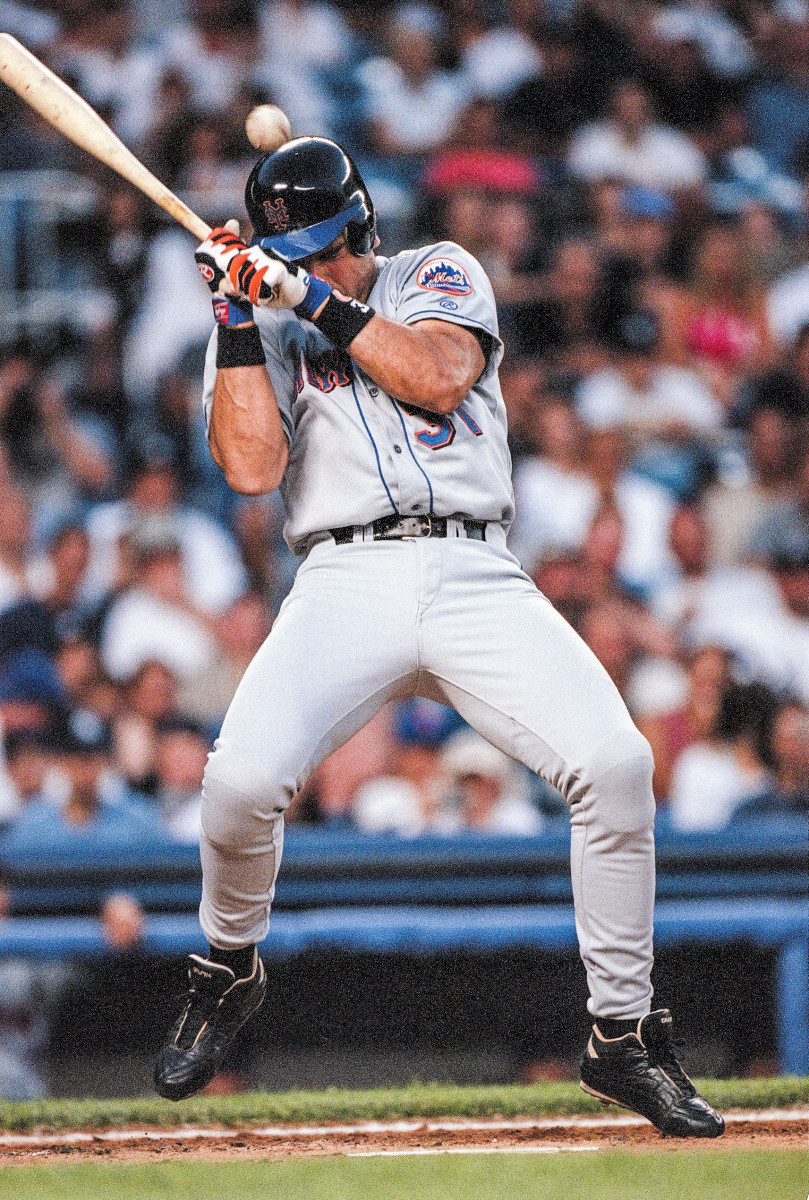
Afterward, Clemens insisted the ball just got away from him, that he was trying to take back the inside of the plate and Piazza accidentally inserted his forehead into its flight path. And maybe that’s what happened. Maybe the multiple-time Cy Young Award winner’s pinpoint control really did abandon him at a very opportune moment. And not in a harmless direction, either—not down into the dirt, or way outside. Right in the noggin. You hate to see it. Such a dangerous sport.
Easily the best part of Piazza’s 2014 memoir, Long Shot, takes place after this beaning incident, when he huddles with a friend—“a karate guy,” Piazza calls him, named John Bruno—to work out a battle plan for Round 5, just in case he had to charge the mound to defend his honor. Piazza did his homework, too. He studied footage of his teammate, third baseman Robin Ventura, charging the mound on Nolan Ryan in 1993, an object lesson in what not to do. For starters, Piazza wrote in his memoir, Ventura lowered his head “as if to tackle him. … That had only exposed him,” he explained. “I would approach with my fist pulled back. I figured he’d throw his glove out for protection. I’d parry the glove and then get after it.”
Piazza laughs when I remind him about this part of his book. “Now I know what people mean when they say they got misquoted in their own autobiography,” he says. It’s all true, he quickly clarifies; it’s just that a crucial bit of comic tone got lost in translation. It was mostly—mostly—a joke. The whole thing was so surreal that at some point you just had to laugh, so Piazza and his pal decided he’d be ready with some Bruce Lee s--- “in case for some reason I did have to go out there and try to take care of business.” It wasn’t some solemn bracing for battle, in other words; it wasn’t Rocky Balboa flipping logs in a Siberian forest. But he wasn’t goofing around, either.
Piazza missed the All-Star Game with a concussion. Clemens pleaded Whoopsie, apologized and somehow avoided suspension. Piazza, though, rejected Clemens’s apology on the grounds that throwing at a man’s head in retaliation for repeatedly getting got is not an apology-accepted situation and more of a to-be-continued situation. The season had to go on, though, so everyone retreated to their neutral corners until, we assumed, the next summer. Then the Mets kept winning, and so did the Yankees. On Sept. 27, the Mets clinched a playoff berth. Two days later, the Yankees backed into the AL East title, losing 13–2 on the field but clinching anyway when the Red Sox lost. Really inspiring stuff. Nine days after that, the Mets knocked off Barry Bonds and the Giants in the NLDS.
Holy s---, Mets fans thought with glee. This might actually happen.
Holy s---, Yankee fans thought with horror. This might actually happen.
And then it did. And then it was Game 2. And then Clemens struck out Timo Pérez to open the game. And then he struck out Edgardo Alfonzo. And then Piazza was up.
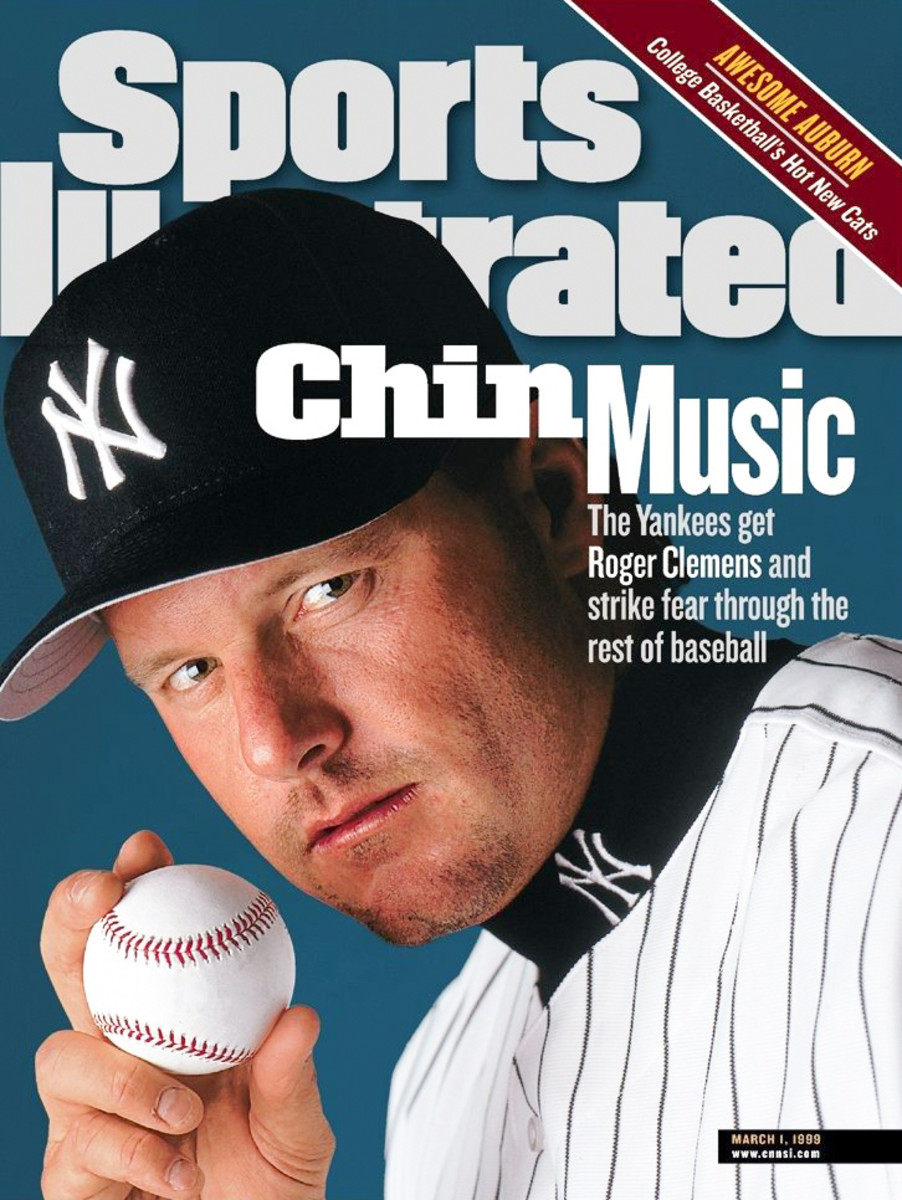
Clemens sits down next to Piazza and puts on a pair of headphones, and the Gridlocked host narrates the moment with stifled amazement in his voice, like he can’t believe this actually worked. “Roger, thanks for sitting here, right next to Mike Piazza, right now,” he says.
There’s no video of any of this, only audio, so we can’t see anyone’s facial expressions or body language, but on the fortunate side, listening to it now is like revisiting a movie scene again when you already know the twist. Every line of dialogue takes on new meaning. If you’d been in the Las Vegas area that day and heard the interview in real time, you’d never know anything was amiss. That’s all because of Piazza, who somehow kept an outward cool and shifted into retired-athlete BS mode with aplomb, never once betraying how badly he wanted to flip the table. Clearly the ESPN guy knew what he was doing. But what about Clemens? Piazza wondered. He had to know, too, right? Clemens had seen Piazza there; he could’ve declined the Gridlocked guy’s invitation, or walked away if he smelled a trap. But he didn’t. He walked right up behind Piazza and sat down right next to him.
Clemens knew. He knew what this was, and he did it anyway.
Perhaps sensing that he’s on the clock, the Gridlocked guy goes straight for the jugular. “Of course,” he says, “what comes to mind with you two guys is the bat-throwing incident in the World Series from back in 2000, the Subway Series.” Of course. He’s so busy being a shock jock that he doesn’t even register the nice one-liner Piazza gets off under his breath.
“Oh yeah,” Piazza says. “I forgot about that.”
The only logical reason for Clemens to sit down next to Piazza during a live radio interview is to talk about the Incident. It is the only thing that connects them. But when the host goes there, however clumsily, it’s Clemens who moves first to shoot him down. “It’s way behind us,” Clemens lies. “Far behind.” Right away he flips allegiances. He was in cahoots with the host to entrap Piazza, but now he’s on Piazza’s side, a brother in arms, united against the lamestream media. Piazza jumps in to help Clemens avoid the subject, but he manages to do it without lying.
“We’re done with baseball, man,” he says. “We’re retired now.”
Clemens could’ve left it there. He could’ve stopped at, We’re cool now. But, for some reason, he goes on. His only contact with baseball now, he says, is serving as a wise old man for “the younger guys” who “come to the house to throw in the off-season.” Sometimes, he says, he’ll refer them to Piazza for a catcher’s perspective. “Anytime I can direct them toward somebody like Mike that is a catcher, that’s wanting to learn,” Clemens claims, “those are the things I tell them to do.”
Piazza is sitting right there. They haven’t spoken in seven years. They both know this. As far as Clemens knows, Piazza still hates him. Instead, Clemens implies, on live radio, a professional bonhomie that simply did not exist.
Everyone in Yankee Stadium that night just seemed confused. It never added up from the moment it happened, and maybe that’s why neither Piazza nor Clemens charged the other, even though on this night, almost any other intersection between them would’ve sparked a brawl. Instead, the look on Clemens’s face made it clear that he couldn’t understand why Piazza was so mad, while the look on Piazza’s face made it clear that he couldn’t understand why Clemens was so mad. They both looked baffled, and in the chest-beating non-ruckus that followed, it was like the pregnant pause after a loud clap, when it’s unclear whether it was a firecracker or a gunshot. If you rewatch the footage, you can see Yankees catcher Jorge Posada trying to play peacemaker. Piazza ignores him, though. He’s too busy untangling the mystery. He still seems dazed.
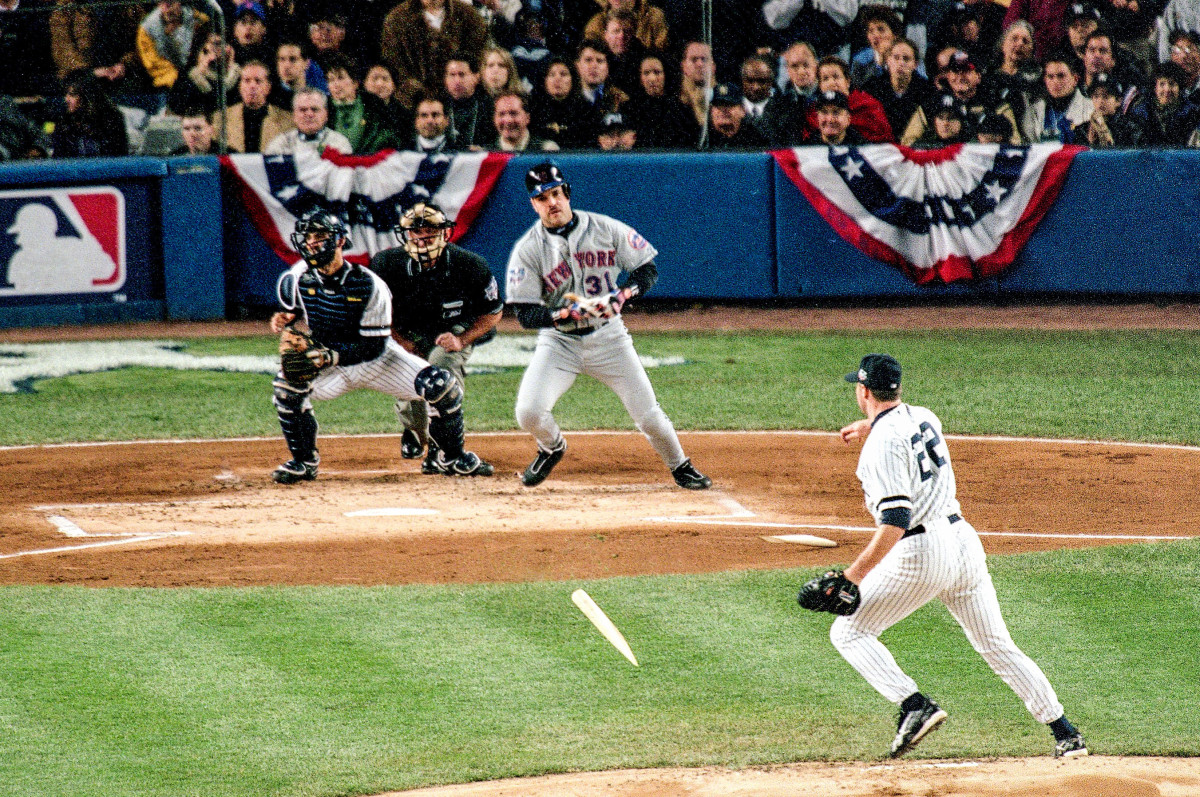
THE INCIDENT
On his third pitch, Clemens threw an inside fastball that jammed Piazza, and when Piazza made contact his bat shattered into three pieces. One piece flew off toward the Mets’ dugout, the broken handle stayed in Piazza’s hand, and the jagged barrel of the bat whipped toward Clemens’s shins like a chainsaw. Piazza had no idea where the ball was—it had trickled away into foul territory—so he started trotting, bat handle in hand, toward first. Clemens had snared the jagged barrel, and once he realized what it was, he flung it out of play toward the Mets’ dugout. But in a quirk of the cosmos that echoes to this day, he nearly hit Piazza with it as Piazza was going up the first base line. And given all the history between them, everyone in the world, except Roger Clemens, thought for sure that Clemens had thrown the bat at Piazza on purpose. The benches emptied, but in the end nothing happened. It fizzled into a garden-variety hold-me-back nonfight.
I don’t care if you think I’m biased: The whole thing was Clemens’s fault, and here’s why. The reason why Piazza was so confused—the reason we were all so sure in the moment that Clemens really did throw a bat at Mike Piazza, on purpose—was the snorting, frothing, psychotic look on Clemens’s face that I think we can now justifiably describe as steroidal. For a brief second, he lost control, he Hulked out, he had a spaz attack. He reportedly stormed back to the Yankees’ clubhouse between innings to calm himself down. I can only assume he was meditating. It’s impossible to know what made him so mad, though, because he’s never explained it—whether there was a logical reason, however mistaken, or if it was simply an adrenaline overload. Whatever it was, he flung that bat like he had a vendetta against it, like he despised bats and everything they stood for. F--- you, bat.
Before the Incident, the Mets were focused and clear-eyed, all of their energy trained on the same spot. Now, though—now they were all mixed up. They got stuck in the moment, wondering if they’d handled it right, or if they’d been punked. They seemed to be searching for how a championship team should respond. WWYD? What Would the Yankees Do?
And the Yankees, meanwhile, just did it. The confusion of the Incident had the opposite impact on them. It made things as clear as the Clear. The Yankees were the Bad Guys, the heels, the bullies, and they embraced it. Might as well drop the gloves and end this thing.
Which is exactly what they did. After Clemens found his bliss and returned to the mound, he got Piazza to ground a meek metaphor to second base, and then he mowed through the rest of the lineup, giving up just two hits and striking out eight over eight shutout innings. The Mets pieced together a rally in the ninth, cutting a 6–0 deficit all the way down to a single run, and Piazza got it going with a two-run homer. Then Mariano Rivera came on and surrendered a three-run home run, because he was bored and he felt like toying with us. Up next for the Mets was reserve shortstop Kurt Abbott, our World Series hopes riding on his .217 batting average. Mo struck him out on three pitches.
The Mets actually won Game 3, but the stars of the night—Rick Reed, who threw six steady innings, and reserve outfielder Bubba Trammell, who iced it in the eighth with a thunderous sac fly—didn’t inspire confidence. It felt like the gimme game of a gentleman’s sweep.
The runs came early in Game 4, with the Yankees leading 3–2 after three innings, but neither side scored the rest of the night. All the Mets needed was for someone to poke a two-run homer and we’d be right back in this series, and yet with every inning that passed I grew more certain that no poke was coming. We weren’t going to pull ahead, we weren’t going to tie it up, we weren’t even going to threaten to score. We were just going to keep grounding meekly to second, and then in the ninth inning, Rivera would come in and smother us with a pillow from the guest suite that Donald Trump keeps for him at Mar-a-Lago. (Aside from the pillow, that’s exactly what happened.)
If the Incident were to happen today, the consensus opinion in the sports world would be that Piazza did the right thing by keeping his head, that Clemens was wrong for going berserker, like he’d just smoked meth in the dugout. There’d be some Barstool Sports types who’d insist Piazza should’ve slugged Clemens, just to keep his team’s blood boiling. But no mature adult would stand by that take. You can’t just go punching people in the World Series—we know that now. Piazza did the right thing. He didn’t let bro codes or pride overwhelm his sense of reason.
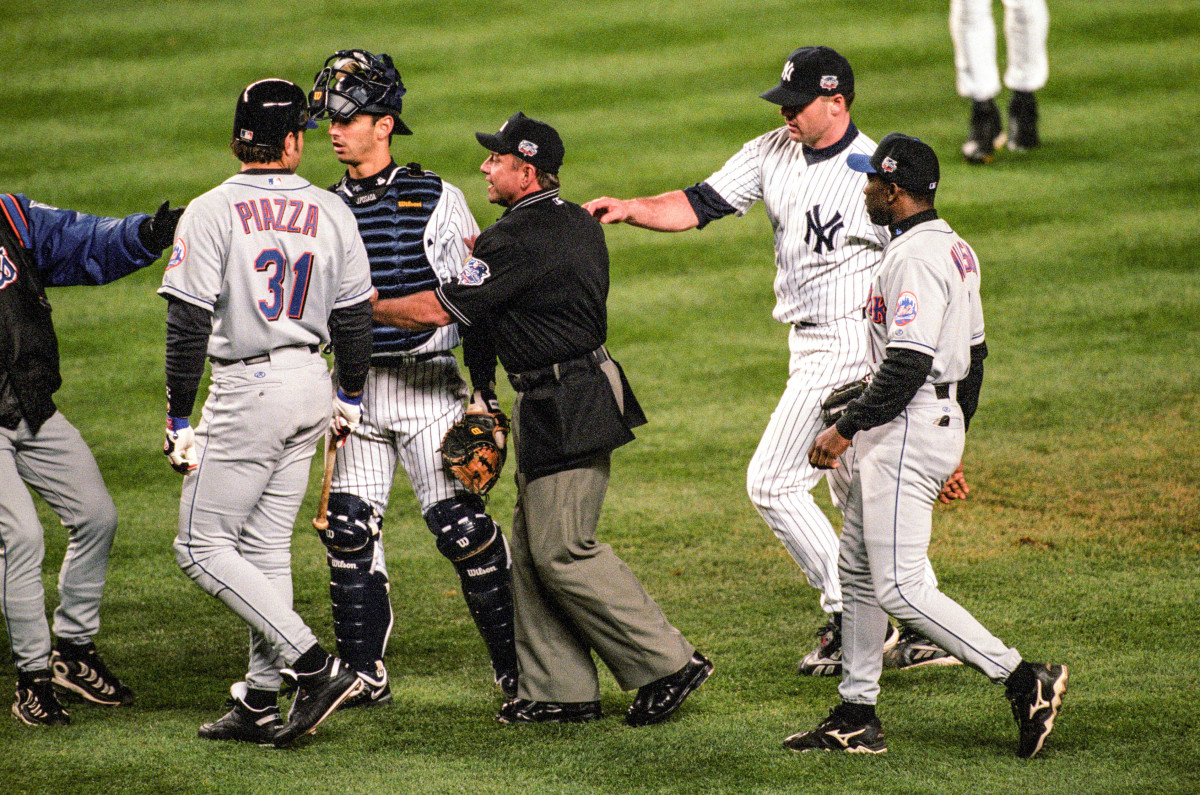
Piazza’s own description of the Incident in his memoir is so methodical that it might only further frustrate anyone who thinks he should’ve just gone ham. “The situation,” he wrote:
...occupied a gray zone in my personal rules of engagement. I had no predetermined response for somebody flinging the jagged end of a bat at my feet, but it fell under the general parameters of being thrown at. When that happens, you’re seldom certain of the intent. You wait to see the pitcher’s reaction. You yell at the guy and check his response. If he yells back, waves you to the mound, spreads his palms, glares at you the wrong way, tells you to get your ass to first base, or in any fashion attempts to intimidate you further, it’s on. If he just rubs the ball and looks in the other direction, I was cool with that. Part of the game.
The look he saw on Clemens’s face, he wrote, “was of the latter variety.” In Piazza’s words, Clemens was “pleading confusion.” “His hurl of the bat had looked blatantly, preposterously violent, and yet, there he stood, admitting his mistake and protesting his innocence. He wasn’t looking for a fight.” And so Piazza didn’t fight him. End of story. And then he homered in the ninth, triggering a near comeback, which proves he did the right thing, right? It’s not like he backed down. Right?
To this day, he’s still not sure. He’s still conflicted. In his heart, he often wishes he’d satisfied the fury he felt, even if it was misplaced. He knows the consequences would’ve been fatal for the Mets—but the truth is we don’t know that. Maybe, just maybe, Piazza punching Clemens in the nose would’ve unleashed such a ferocious battle cry that we would’ve rode the sound to an improbable upset. Weren’t miracles our thing? All of a sudden we think we’re gonna win a World Series with talent? Maybe that really was our chance.
Plenty of his teammates thought so. Mets reserve outfielder Darryl Hamilton, a 12-year veteran by that point, savaged Piazza years later in Jeff Pearlman’s book about Clemens, The Rocket That Fell to Earth:
When he was hit in the head I understood because he was shaken up. But in the World Series, why were you confused? This guy threw a bat at you, and you do absolutely nothing? You don’t stand up for yourself? You don’t defend your manhood? Baseball is a game of pride, and we were all getting on Mike. “Where’s your pride, man? Where’s your pride?”
Baseball is a game of pride. Wounded pride is why Hamilton struck out twice and went hitless in his final five postseason at bats, and why Mike Hampton, the Mets’ Game 2 starter against Clemens, was wild all night, giving up five walks, along with eight hits and four runs, over six innings.
Piazza had dominated Clemens so thoroughly that Clemens snapped on live TV in front of the whole world, but according to his own teammates, according to the local media, according to the knuckleheads calling in to Mike and the Mad Dog, Piazza was the one who’d blown it. By the end of the saga, the whole thing left Piazza disgusted.
“There had been so much public clamoring to see Clemens and me go mano-a-mano, such a loathsome display of bloodlust, that I wanted no part of it for that very reason,” Piazza wrote in Long Shot. “It’s my job to feed the mob? I have to run out and fight Roger Clemens because the fans expect me to?”
Initially, as Piazza described the Vegas sports-radio encounter with Clemens, I grew concerned that the audio might no longer exist. And if it did, did it really happen the way Piazza says it did? Did he handle it as coolly as he claims? Or did he squirm and pout and then ground out to second?
It happened just the way Piazza says it did. Google it. The YouTube clip has about 8,000 views and at least a hundred of them were me. In order to keep the host at bay, Clemens shifts the conversation to golf, which is shrewd. Golf is universally recognized as neutral territory. A man can talk about golf with his worst enemy. And so for a minute, Piazza talks about golf with his worst enemy.
The host, though, keeps lobbing sticks of dynamite at Clemens. He brings up Barry Bonds’s legal woes, the steroids investigation unfolding in parallel to Clemens’s, and now you can hear in Clemens’s voice that he’s starting to rue his decision to crash this interview. Piazza tries every strategy he can to lower the heat—he gets off a good wisecrack about Bonds’s snitchy ex-girlfriend, to which even Clemens gives a nervous hardy-har-har.
“I’m just glad I didn’t date his girlfriend,” Piazza jokes. “That’s all I have to say on that, man.”
Finally, though, Piazza decides he’s had enough. He waits for an opening to say something reasonable, about how hard it is to hit a baseball, and that history is what it is and we can’t change it, but let’s not let that overshadow, etc., etc. And then as soon as he puts a period on the sentence, he stands up, abruptly but politely. “I’m gonna get going, man,” he says, seemingly to Clemens, and as he speaks we can hear his voice get farther away from the microphone. “Pleasure to see you guys.” And then he ghosts.
As soon as he’s gone, the host hits Clemens below the belt. He brings up the Rocket’s PED-popping partner in crime, Andy Pettitte, the Judas of the Yankee dynasty, via veiled references to “he said–he said” and “former friends who are speaking out.” Now finally, Clemens blows his stack. “You’re wrong again,” he snaps, twice. “All you have to do is know how to read. Do you know how to read?”
It kills me that I can’t see the look on Clemens’s face, or Piazza’s as he glides away. I like to imagine Piazza with a smirk on his face, whipping on a pair of shades, like the cool guy in a Michael Bay movie walking away from an explosion.
Since I’ve been a bit tough on the Yankees so far, I feel bound to point out that neither of the protagonists in this story is easy to love. Piazza spent his career trying to emulate his childhood idols, Mike Schmidt and Ted Williams: aloof, laser-focused, not here to make friends. Williams, the Splendid Splinter himself, the man many people consider the greatest hitter ever, was Piazza’s teenage batting tutor. Lasorda hooked them up. Piazza saw himself as a guy who’d earned everything through hard work; many of his Piazza’s teammates saw him as a spoiled kid who started life on third base. Unlike Clemens, though, Piazza is reflective and self-aware. In his book, he cops to all of it. He regrets acting like a jerk; he wishes he’d been a better leader. Sometimes he needed to be a jag-off to fuel himself, he’s sure of that much. He’s self-diagnosed OCD and saddled with all the needling anxieties that that entails. As a result, his regrets always seem to come with a tinge of self-defense. But he wishes he’d savored the experience more. Laughed more. Hung out more.
And when it comes to that era’s elephant in the room, performance-enhancing drugs, and the eternal mystery of who was and who wasn’t using them, Piazza was no innocent. He never tested positive, and his name never appeared in any report. But he has also admitted that he used androstenedione (aka Andro), the legal supplement spotted in Mark McGwire’s locker, which broke the dam on the PED conversation, and that he only stopped when baseball outlawed it. There was plenty of circumstantial evidence to convict him in the press—the 62nd-round pick turning into the best hitting catcher ever, the back acne. There was plenty of circumstantial evidence in the other direction, too. His power numbers never spiked upward. He could always hit the ball a mile. His body never shapeshifted. What blossomed was his batting eye and his ability to hit for a high average (Ted Williams). None of it is dispositive, though, and it’s a simple fact that every big number from that era has to be regarded with some measure of skepticism.
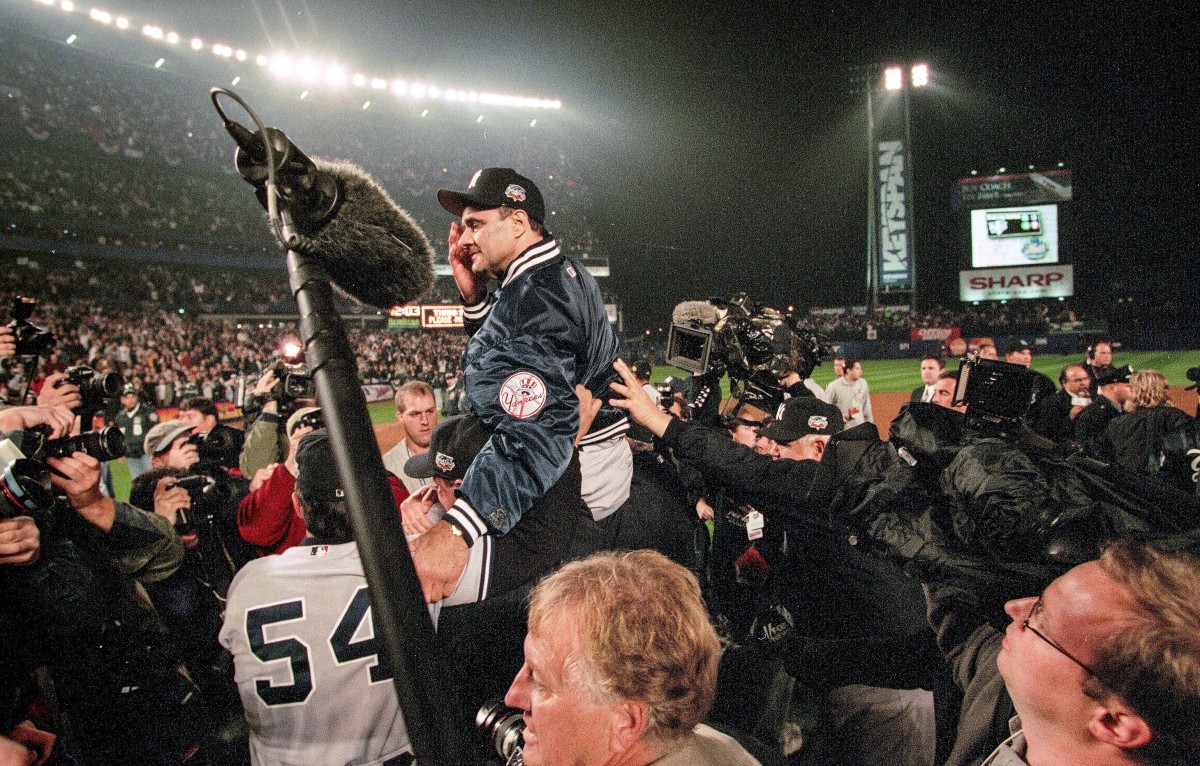
No skepticism is required with Clemens. By 2011, he was deep in the stew over PED use. Pettitte had already declared in a sworn affidavit that Clemens told him about his training regimen of needles to the butt cheek. And yet Clemens kept on denying that he was a cheater. Every time he opened his mouth, he made it worse. Off the field, out of uniform, Clemens seemed lost. By the time he and Piazza crossed paths at Jordan’s tournament in ’11, Piazza was settling into a blissful life of golf and pasta and raising kids with his Playboy Playmate wife. Clemens, meanwhile, was hardening into a sports villain, locking himself out of Cooperstown, spending his days giving advice to all the young ballplayers out there, and getting deposed by all the ambitious young prosecutors out there.
It’s well after midnight in Italy now, so late that it’s nearly prime time here in the States. Game 4 of the 2019 ALDS between the Rays and the soon-to-be-disgraced Astros. We’re coming up on the anniversary of the Incident, and Piazza knows that if he can’t sleep and he’s got the TV on that night, soon enough he’ll be watching himself, trying all over again to figure out what the hell just happened. They show it every year this time.
It’s funny that Darryl Hamilton used the word “pride” so often to savage Piazza, because Piazza has always taken pride in how he comported himself that night during the Subway Series. Which is to say: like a mature adult. Like a professional. Like a man with principles. He has nothing to atone for with any higher powers. You don’t get to choose how or when those moments come, and that’s the whole point. They’re a truth serum. They happen, you react, and you’re stuck forever with how you performed.
In that moment, Clemens showed himself to be the perfect vessel for the curdled superego of Yankee Nation—a core conviction that winning answers all questions and excuses all sins. Just win, baby. Winning isn’t everything, it’s the only thing. Yankees fans might be the only people left who have any warm feelings at all toward Clemens, and even most of them are only kosher with him because he held up his end of their devil’s bargain. The rings made it all O.K. That’s the Yankee way. Their fans pride themselves on the tidiness of this epistemology. While you’re busy being reflective, they’re busy kicking your ass.
Maybe Clemens is haunted by his decisions, too. Maybe he has his own dark nights of the soul. Maybe there’s a person in there with a rich inner life. Or maybe he’s just a creep. They do exist, you know. I admit I’m not disposed to give Roger Clemens the benefit of the doubt—but I’m sorry, I just don’t believe he spends any part of his day revisiting the ethics of his choices and wondering if he’d made some shameful mistakes. I think he’s still spitting mad. I think he thinks this is all bulls---. I think he can’t believe he’s not in the Hall of Fame yet—he’s been eligible for eight years now, and he still hasn’t come close to the 75% vote threshold—and I think he can’t believe he might run out of chances. Why is he being singled out? Why’s everyone gettin’ all high and mighty now? Since when has being a good person ever been part of the criteria for getting into the Hall of Fame? Ty Cobb is in there!
Perhaps Clemens’s counsel has advised him to just ride this thing out, wait for the landscape to change, and eventually voters will remember his seven Cy Young Awards. We’ll see. He’s only got one shot left. There was a time when the verdict of history was in Clemens’s hands. But not anymore.
During his induction speech, Piazza spoke about how the emotion of Mets fans fueled his own emotions—how they booed him when he struggled through his first few months at Shea, how he, recognized in those boos the tentative love of fans who weren’t sure yet whether to put their trust in him, and how that made him want to earn it. He was as perfect for the Mets as Clemens was for the Yankees. Fate couldn’t have cast the roles any better. Piazza bleeds, like we do. He’s unresolved about his past, conflicted, human. And this is the person he’d rather be. He doesn’t want to be Clemens, so single-minded that it rots the soul.
The ring-shaped hole in Piazza’s résumé will always eat at him—he never did get back to the World Series. But it was bound to be something. Piazza is the type of guy who always has something eating at him. It’s part of what makes him tick, and retirement offers you less escape from yourself. It’s as good a wound as any for this Catholic boy to keep pouring salt into. And anyway, it’s better to wonder about the mysteries of the universe and the way a bat hurtles through the air and how easily things could’ve gone differently than to look back with regret at your ugliest moments, when the worst parts of yourself drove the worst decisions of your life.
Piazza alludes on the phone to his OCD more than once. He needs things to be perfect, clean, meticulously selected, and in fact, the pain-in-the-ass of it, of being him, is getting too much for the family to keep their house in Miami—it’s big, and the lawn, and all of it—and now they’re never even there. Life’s too short. So he just put it on the market. (“It’s with Coldwell Banker. If anyone wants to make an offer.”)
He talks about his OCD with easy self-awareness, like a born Met. Oh well. What are you gonna do? But it was that same tirelessly exacting eye that made him such a special hitter, like a silent rebuttal to all the PED accusations of the era. Doubt the home runs all you want—how do you explain .362? He had no choice but to be a maniacal perfectionist. His brain gave him no other options. He never did win a World Series, but he came out on the other side with his soul intact. Clemens has the rings, but his best friend narc’d on him, he’s locked out of the Hall of Fame, and even if he gets in, his reputation as one of baseball’s great turds is etched in marble. His name doesn’t mean winner anymore. It means cheater.
Piazza wishes sports fans were complex enough for the kind of emotional texture and moral ambivalence that he can’t help feeling. But most of the time, he’s just like the rest of us, even Mets fans: drawn to sports because of the satisfying closure they provide. Clarity amid chaos. In sports, facts are facts, and they remain stubborn for centuries to come. Clemens won. Piazza lost. The Yankees won. The Mets lost.
So now that we’ve tallied it all up, let’s do Piazza versus Clemens one last time: Whose eternity would you rather have?
